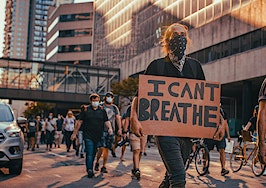As protests against police brutality and racism consume the country, luxury real estate finds itself having to grapple with an uncomfortable fact. This branch of the industry, which focuses on multi-million-dollar homes and some of the country’s most expensive neighborhoods, has often been the opposite of inclusive.
Black families in the United States had a homeownership rate of 44 percent compared to 71 percent of white families in 2017, according to Redfin’s latest study. When you zoom into neighborhoods known for having high property values and high-end homes, the gap gets even more stark. In San Diego’s top neighborhoods, for example, the homeownership rate for white families was 60.9 percent while for Black families it was only 17 percent. In Sacramento’s top neighborhoods, the difference is 73.4 percent compared to 16.7 percent.
There are both historic and present-day reasons for such inequality. Redlining, a practice in which banks, insurance companies and businesses limit loans, mortgages, insurance and even community services to specific areas, has widened the wealth gap and lowered the value of homes in particular neighborhoods since the 1930s.
While redlining was outlawed with the passage of the Fair Housing Act of 1968 and the Community Reinvestment Act of 1977, its effects linger today. Redfin found that a home in a once-redlined neighborhood is typically worth $212,023 less than a home in a once-greenlined neighborhood. Black Americans, meanwhile, are 4.7 times as likely to own a home in an area that was most heavily redlined in the past.
This perpetuates a cycle in which certain groups, most often Black people and other people of color, are often prevented from building real estate wealth or even getting close to owning the kind of valuable high-end property accessible to other Americans.

La Toya Tolbert-Watson
“A house or a condo can be a stepping stone for building wealth and buying property,” said La Toya Tolbert-Watson, a Realtor working with both luxury and affordable homes in West Hollywood in Los Angeles. “But if you don’t build enough affordable housing, where are people going to start?”
Named as one of Realtor Magazine’s top 30 Under 30 agents in 2017, Tolbert-Watson regularly hosts seminars encouraging people in her community to make the leap to homeownership and take advantage of the equity in their current homes. But one of the biggest hurdles keeping her clients back has been L.A.’s sky-high prices. With the average price of a home in the city at $752,508, it becomes extremely difficult for someone who does not already own a home or have a high income to get one.
“We see the problem and the statistics are there but people are not doing enough to help,” Tolbert-Watson said. “You have all this money and projects that are granted as far as gentrification is concerned, but what are you doing to help those that are pushed out because of the gentrification?”

Tai Christensen
As things stand, Black people often get left out of high-end real estate for a host of interconnected reasons — income disparities, home value disparities and outright discrimination. Tolbert-Watson said that she’s felt unwelcome in many high-end neighborhoods — as part of her real estate work, she’s knocked on doors in Orange County and been called slurs in return.
Meanwhile, historically African American neighborhoods are often displaced as developers move to build more luxury homes in the area, as was the case with Sag Harbor Hills, a neighborhood bordering the Hamptons in New York.
Tai Christensen, the director of governmental affairs at CBC Mortgage Agency, said that down payment assistance and various grants can be one of the most significant ways to help historically disenfranchised communities build wealth. A single home can break the cycle of poverty and make it easier for subsequent generations to get the kind of luxury homes that many in this country dream of.
“When you change that dynamic and vision, you change the neighborhood one street at a time,” Christensen said. “That home has become an asset to [the family] which increases the value of the neighborhood and increases the value of the whole city slowly, person by person and street by street.”
While everyone’s idea of what constitutes wealth and luxury will differ, the current period of racial and political unrest can be a crossroads in which people of all races can work towards having a home, live in the neighborhood they choose and be able to create better opportunities for their children through homeownership, Christensen said.

Nancy Almodovar
“It does nothing if 1 percent of our country owns 90 percent of the wealth,” she said. “That just creates minority communities that live in a perpetual state of lack.”
Nancy Almodovar, the president of the Christie’s International Realty-affiliated Nan & Company Properties in Houston, leads a brokerage that works with homes worth from $200,000 to more than $8 million. She said the change towards making luxury real estate more inclusive starts from the bottom up — from having more diverse agents work in the field to changing long-running misconceptions about who lives in which neighborhood.
“In the past, we’ve seen one or two players in town really ‘own’ certain areas or neighborhoods because that’s how it has been for years and years,” Almodovar said. She believes that agents can be the harbingers of making luxury accessible to all regardless of the color of their skin — by challenging pre-conceived assumptions and giving opportunities to those who need them.
“Innovative thinking and open minds will move the industry forward to become more inclusive,” she said. “As long as buyers, sellers and Realtors are able to evaluate someone’s merit based on their work, and not the color of their skin, then we will continue to make steps towards a less exclusive industry.”













